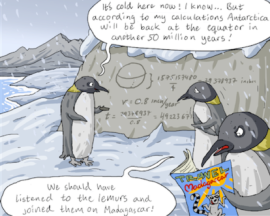 This week has been all about biogeography for me. While I wouldn’t call myself a ‘biogeographer’, I certainly do apply a lot of the discipline’s techniques.
This week has been all about biogeography for me. While I wouldn’t call myself a ‘biogeographer’, I certainly do apply a lot of the discipline’s techniques.
This week I’m attending the 2013 Association of Ecology’s (INTECOL) and British Ecological Society’s joint Congress of Ecology in London, and I have purposefully sought out more of the biogeographical talks than pretty much anything else because the speakers were engaging and the topics fascinating. As it happens, even my own presentation had a strong biogeographical flavor this year.
Although the species-area relationship (SAR) is only one small aspect of biogeography, I’ve been slightly amazed that after more than 50 years since MacArthur & Wilson’s famous book, our discipline is still obsessed with SAR.
I’ve blogged about SAR issues before – what makes it so engaging and controversial is that SAR is the principal tool to estimate overall extinction rates, even though it is perhaps one of the bluntest tools in the ecological toolbox. I suppose its popularity stems from its superficial simplicity – as the area of an (classically oceanic) island increases, so too does the total number of species it can hold. The controversies surrounding such as basic relationship center on describing the rate of that species richness increase with area – in other words, just how nonlinear the SAR itself is.
Even a cursory understanding of maths reveals the importance of estimating this curve correctly. As the area of an ‘island’ (habitat fragment) decreases due to human disturbance, estimating how many species end up going extinct as a result depends entirely on the shape of the SAR. Get the SAR wrong, and you can over- or under-estimate the extinction rate. This was the crux of the palaver over Fangliang He (not attending INTECOL) & Stephen Hubbell’s (attending INTECOL) paper in Nature in 2011.
The first real engagement of SAR happened with John Harte’s maximum entropy talk in the process macroecology session on Tuesday. What was notable to me was his adamant claim that the power-law form of SAR should never be used, despite its commonness in the literature. I took this with a grain of salt because I know all about how messy area-richness data can be, and why one needs to consider alternate models (see an example here). But then yesterday I listened to one of the greats of biogeography – Robert Whittaker – who said pretty much the complete opposite of Harte’s contention. Whittaker showed results from one of his papers last year that the power law was in fact the most commonly supported SAR among many datasets (granted, there was substantial variability in overall model performance). My conclusion remains firm – make sure you use multiple models for each individual dataset and try to infer the SAR from model-averaging.
But that’s only one stimulating aspect of Whittaker’s talk. I was very interested in the addition of (oceanic) island age to the simple bivariate SAR. Here he showed how true island biotas also shift merely as a function of their age since appearance, with often a higher richness in some taxa in the mid-range of ages. I believe there’s a lot of potential to add something analogous to continental (fragment) island SAR endeavours, which is the subtlest of hints that I am co-author of a rather important paper on just such an issue that is nearing the final stages of revision (stay tuned on that one).
One last mention before I end – Tim Blackburn gave a fantastic talk about his work on invasive species SARs (Tim is also a close colleague of our joint lab head, Phill Cassey), with the conclusion that while invasive species generally follow the power-law SAR, they often do with rather different intercepts and sometimes even different slopes. This means that despite the very different mechanisms underlying their invasion processes, area limits their diversity as well. What was more fascinating though was that human population density was a better predictor of invasive species richness than area in the datasets he had managed to collect! Enter his ‘SPHU’ (species-human relationship) – a most Blackburnian acronym. I think there’s a lot more potential here, especially if we take some of Whittaker’s ideas and apply age since introduction into the mix, and perhaps look at the influence of the invasives on the native species SARs. Fascinating stuff!
That’s all from me at INTECOL for now – I’m sure I’ll think of more about which to blog in coming weeks.
CJA Bradshaw

